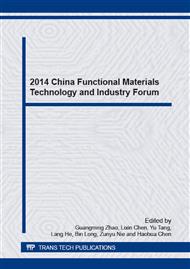[1]
Mike Buttery, SPACE TRIBOLOGY Course 2011, ESR Technology Ltd. 2011, 249-250.
Google Scholar
[2]
L. Fusaro Robert, Self-Lubricating Polymer Composites and Polymer Transfer Film Lubrication for Space Applications, NASA Technical Memorandum, 1990, 102492, 3-4.
DOI: 10.1016/0301-679x(90)90043-o
Google Scholar
[3]
Jaydeep Khedkar, Ioan Negulescu, Efstathios Meletis I. Sliding wear behavior of PTFE composites, Wear 2002, 252, 361–9.
DOI: 10.1016/s0043-1648(01)00859-6
Google Scholar
[4]
J. R. Jones, M. N. Gardos, Transfer Film Formation by Lubricative Composites, Proc. Int. Conf. Solid Lubricant, 1971, 185-197.
Google Scholar
[5]
Dinghan Xiang, Zhengjun Yao, Jianping Wen, Experimental investigation on dry frictional behavior of the two self-lubricating composites under heavy loading conditions, Mater. Lett., 2005, 59, 2352–2356.
DOI: 10.1016/j.matlet.2005.02.078
Google Scholar
[6]
Wang Yunxia, Yan Fengyuan, A study on tribological behavior of transfer films of PTFE/bronze composites, Wear 2007, 262, 876–882.
DOI: 10.1016/j.wear.2006.08.026
Google Scholar
[7]
Zhi-ning Jia, Yu-lin Yang, Jin-jiang Chen. Influence of serpentine content on tribological behaviors of PTFE/serpentine composite under dry sliding condition, Wear, 2010, 268, 996–1001.
DOI: 10.1016/j.wear.2009.12.009
Google Scholar
[8]
Zhining Jia, Yulin Yang, Self-lubricating properties of PTFE/serpentine nanocomposite against steel at different loads and sliding velocities, Composites: Part B, 2012, 43, 2072-(2078).
DOI: 10.1016/j.compositesb.2012.01.014
Google Scholar
[9]
H. Unal, A. Mimaroglu, U. Kadroglu, etc., Sliding friction and wear behavior of polytetrafluoroethylene and its composites under dry conditons, Mater. Design, 2004, 25, 239-245.
DOI: 10.1016/j.matdes.2003.10.009
Google Scholar
[10]
YQ Wang, J Li. Sliding wear behaviour and mechanism of ultrahigh molecular weight polyethylene. Mater . Sci. Eng. A 1999, 266, 155–60.
Google Scholar
[11]
S. K. Rhee, Wear equation for polymers sliding against metal surfaces, Wear, 1970, 16, 431-433.
DOI: 10.1016/0043-1648(70)90170-5
Google Scholar
[12]
Standard Test Method for Ranking Resistance of Plastic to Sliding Wear Using Block-on-Ring Wear Test-Cumulative Wear Method, ASTM G176-03.
DOI: 10.1520/g0176-03r09
Google Scholar
[13]
R.K. Eby, K.M. Sinnott, Transitions and relaxations in polytetrafluoroethylene, J. Appl. Phys., 1961, 32, 1765-1771.
DOI: 10.1063/1.1728433
Google Scholar
[14]
Erwin V. Zaretsky, Tribology for Aerospace Applications, STLE Publication SP-37, 1997, 103-128.
Google Scholar


